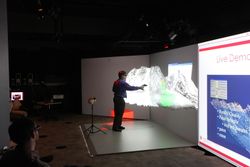Immersive Visualization / IQ-Station Wiki
This site hosts information on virtual reality systems that are geared toward scientific visualization, and as such often toward VR on Linux-based systems. Thus, pages here cover various software (and sometimes hardware) technologies that enable virtual reality operation on Linux.
The original IQ-station effort was to create low-cost (for the time) VR systems making use of 3DTV displays to produce CAVE/Fishtank-style VR displays. That effort pre-dated the rise of the consumer HMD VR systems, however, the realm of midrange-cost large-fishtank systems is still important, and has transitioned from 3DTV-based systems to short-throw projectors.
Vrui
Vrui VR integration library
Vrui is a VR integration library from the University of California at Davis' KeckCAVEs facility. Vrui takes the approach of providing a framework into which applications are integrated and can take advantage of many different plugin tools and navigation controls that are independently created from the application.
There are pre-existing Vrui_Applications written at UC-Davis and DRI/INL as part of our immersive visualization ensemble. But before using a Vrui application, one must first install and configure Vrui.
Vrui Versions
There are currently two branches of Vrui (the 1.0 line and the 2.x line). There are some significant differences, including many changes to the API, as well as to the DeviceDaemon protocol.
If you have applications written for both the 1.x and 2.x lines of Vrui, then you will need to have both installed. Fortunately, this is rather easy to do, and following these directions will ensure that your system will work with multiple versions of Vrui installed.
This page has most recently been updated for Vrui version 2.7-001. At the same time I have removed specific references to the Vrui 1.0 line, but as this is a wiki, past versions are saved in perpetuity:
Vrui Dependencies
Basic Vrui depends only on two packages which are generally installed on any self-respecting computer:
- OpenGL
- X-windows
There are also a number of highly-recommended packages that will enhance Vrui:
- zlib-devel
- libpng-devel
- libjpeg-devel
- libtiff-devel
- libasound2-dev
- bluez-libs-devel
Installing Vrui
These instructions have been tested with Vrui version 2.7-001, but should generally work for other versions of Vrui.
- Download Vrui
- Download from the Vrui Download page
- Untar in a local directory
% tar -zxf Vrui-2.7-001.tar.gz% cd Vrui-2.7-001
- Adjust the makefile
% $EDITOR makefile- set
INSTALLDIRto "/opt/VR/Vrui-2.7-001"- NOTE: adding the build-version to INSTALLDIR helps avoid issues when upgrading
- set
- Fix a bug (update tracking for single tracker)
% $EDITOR VRDeviceDaemon/VRDeviceManager.cpp- Change: "
if(trackerReportMask==fullTrackerReportMask)" to "if(trackerReportMask != 0)"
- Change: "
- Compile
% make -j 8- (this will take less than a minute)
- Install
% sudo make install
That's it!
Configuring Vrui
Configuring Vrui can be a very difficult task. A general hint is to find a working configuration setup that's close to what you want to do and then modify! As we gain more experience, we will put more specific advice/instructions here.
In the meantime, here are links to other sources of information:
- KECKCAVES Wiki page on Vrui Configuration
- Oliver Kreylos' Vrui online documentation has three pages on configuration:
As of Vrui version 2.7, there is a handy Vrui application called "DrawEnvironment"
that will display a representation of the screens and tracked objects of the current configuration.
This can come in quite handy when troubleshooting configuration difficulties — of course,
you need to have something partially working to make use of it.
Here are some unorganized bits of information as I encounter them during my trials (and tribulations):
- Comments are denoted with the hash (
#) symbol through the end-of-line - When discussing Vrui configuration options, a directory-like syntax is used by the Vrui library (but not the configuration file). In the configuration files, sections have sections within them.
- In Vrui.cfg, the "root" section is the one selected for use, when not specified on the command line with the
-rootSectionoption it defaults toDesktop - In theory Vrui can use any coordinate frame. In practice, use Z-up since applications seem to assume this.
- thus, always set
root/upDirection (0.0, 0.0, 1.0)
- thus, always set
- Windows and Screens go hand-in-hand (I'd prefer them to be a single entity)
- root/displayCenter — the place where the world will go when centering the display (including initial location)
- root/displaySize controls the relative size that the vis-world is rendered. A good rule-of-thumb is to set this to be half the front screen's diagonal
Compiling Vrui Applications
Vrui comes with some example programs that can be quickly compiled and used for experimentation.
- Adjust the makefile
% cd ExamplePrograms% $EDITOR makefile- for Vrui 2.x: set
VRUI_MAKEDIRto "/opt/VR/Vrui-2.7-001/share/make" - for Vrui 1.x: set
VRUIDIRto "/opt/VR/Vrui-1.0-068"
- for Vrui 2.x: set
- Compile
% make
- Run
% ls bin% bin/VruiDemo- This should open a window with a spinning cube.
See Also
- Oliver Kreylos' Vrui page
- Changes between Vrui 1.x and 2.x
- IU AVL Wiki's Vrui page (which will often be in sync with this page) (Login required)
- An unofficial continuation of the Vrui 1.x series
